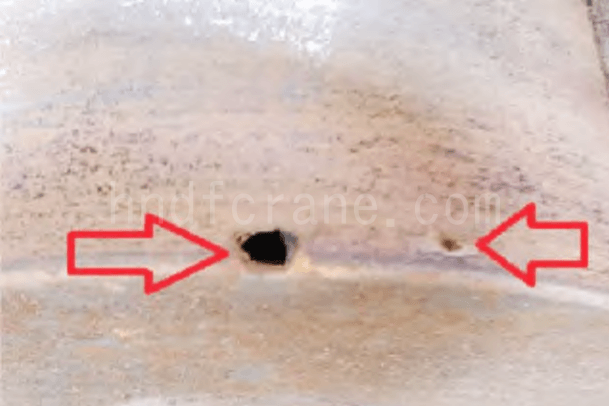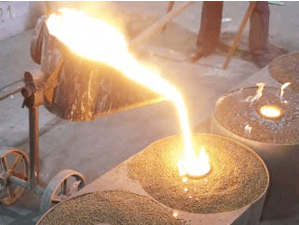Ausfall der Bremsräder von Brückenkränen: Ursachen und Behandlung kreisförmiger Oberflächendefekte
Inhaltsverzeichnis

Da es sich bei Brückenkränen um Schlüsselgeräte in der industriellen Produktion handelt, wirken sich ihre Sicherheit und Zuverlässigkeit unmittelbar auf die Produktionseffizienz und Betriebssicherheit aus.
Das Bremsrad des Brückenkrans ist ein wichtiger Bestandteil des Brückenkrans. Während des Bremsvorgangs ist es hoher Reibung und starkem Druck ausgesetzt, sodass es anfällig für verschiedene Defekte ist, die den normalen Betrieb und die Lebensdauer des Krans beeinträchtigen.
Mit der weit verbreiteten Verwendung von Brückenkränen in verschiedenen rauen Umgebungen hat die Ausfallhäufigkeit von Bremsrädern allmählich zugenommen, insbesondere das Auftreten von kreisförmigen Defekten, was den sicheren Betrieb der Geräte ernsthaft gefährdet. Der Großteil der bestehenden Forschung konzentriert sich jedoch auf häufige Defekte. Als Schlüsselgerät in der industriellen Produktion wirken sich die Sicherheit und Zuverlässigkeit von Brückenkränen direkt auf die Produktionseffizienz und Betriebssicherheit aus.
Das Bremsrad eines Brückenkrans ist ein wichtiger Bestandteil der Bremsräder eines Brückenkrans, beispielsweise oberflächliche Risse und Verschleiß. Zu den kreisförmigen Defekten auf der Oberfläche der Bremsräder eines Brückenkrans und ihren Ursachen wurde dagegen relativ wenig geforscht. In diesem Artikel werden die kreisförmigen Defekte der Bremsräder von Brückenkranen analysiert, die spezifischen Ursachen untersucht und wirksame Behandlungsmaßnahmen und Präventionsstrategien vorgeschlagen.
Durch eine umfassende Erörterung des Gießverfahrens, des Wärmebehandlungsprozesses und der Betriebsumgebung bietet es praktische Hinweise zur Zuverlässigkeit der Bremsräder von Brückenkränen.
Hauptdefekte und Analyse der Bremsräder von Brückenkränen
Einfluss von Umweltfaktoren auf Brückenkräne
Erstens arbeiten Brückenkräne normalerweise in Umgebungen mit mehr Staub und Metallverunreinigungen. Verunreinigungen können leicht in das Innere der Maschine gelangen und so den Verschleiß der Teile erhöhen. Auf lange Sicht wird die Ausfallrate steigen, die Betriebssicherheit wird abnehmen und die Lebensdauer wird erheblich verkürzt.
Zweitens wird der Einfluss der Größe und Art der Arbeitslast des Krans auf den Kran im Normalbetrieb, wenn die Belastung der Teile größer ist als die durchschnittliche Auslegungslast, den Verschleiß der Bremsplatten verstärken und Bremsräder für Brückenkräne. Langfristiger Betrieb mit hoher Last wirkt sich auf die Lebensdauer des Krans aus. Die Praxis hat gezeigt, dass stabile Lasten weniger Verschleiß, weniger Ausfälle und eine längere Lebensdauer aufweisen.
Defekte an Bremsrädern von Brückenkränen
Die Bremsräder des Brückenkrans bestehen aus mehreren Gussteilen. Die beim Gießen auftretenden Defekte spiegeln sich zwangsläufig im Bremsrad wider, was sich hauptsächlich in folgenden Aspekten äußert:
- Es zeigt sich an der Außenseite des Schmiedestücks, beispielsweise in Form von rauen Außenflächen, Vertiefungen, Knicken, ungefüllten Stellen, Falten, Rissen usw.
- Einige davon treten im Inneren auf, wie z. B. Lockerheit, Risse, grobe Kristalle, Haarrisse, weiße Flecken, Entmischung, Einschlüsse, Oberflächenentkohlung, dendritische Kristalle, grobe Kristallringe, Schrumpfungsreste, Nichteisenmetalldurchdringung, Oxidfilm, Stromlinienstörungen usw.
- Einige spiegeln sich in der Mikrostruktur wider, beispielsweise die Ausfällung der zweiten Phase.
- Einiges davon spiegelt sich in der Leistung von Schmiedestücken wider, wie z. B. unzureichende Festigkeit oder Plastizität bei Raumtemperatur, Zähigkeit, Ermüdungseigenschaften usw., Momentfestigkeit, Dauerfestigkeit, Dauerplastizität, Kriechfestigkeit und andere Hochtemperatureigenschaften oder Heiß- und Kaltermüdungseigenschaften erfüllen nicht die Anforderungen der Verwendung. Ob es sich nun um Oberflächenqualitätsprobleme von Kranradschmiedestücken oder um interne Leistungsmängel handelt, sie beeinflussen sich normalerweise gegenseitig, sind oft eng miteinander verbunden, begleiten sich gegenseitig und bilden einen Teufelskreis.
Entdeckung von Defekten an Bremsrädern von Brückenkränen
Aufgrund der häufigen Nutzung und der großen Lastschwankungen kommt es bei Brückenkränen häufig zu Anlauf- und Bremszyklen in den verschiedenen Mechanismen. Innerhalb eines bestimmten Zeitraums, in dem Bremsvorgänge durchgeführt werden müssen, ist ihre Bremsleistung oft nicht optimal. Gleichzeitig mangelt es vielen Kranführern an professionellen und qualifizierten Bedienkenntnissen.
Während des Betriebs neigen sie den Kran häufig schräg, und die zu hebende Ladung befindet sich nicht am Lotpunkt des Hebepunkts. Bevor der Hebepunkt des Krans an Ort und Stelle ist, müssen sie das Fahrzeug umkehren, um den Zweck des Bremsens an Ort und Stelle zu erreichen. Darüber hinaus kommt es während der Arbeit des Krans häufig zu Reibung zwischen der Bremsplatte und dem Bremsrad, und die Bremsplatte wird bis zu einem gewissen Grad abgenutzt, wodurch die Bremsräder des Brückenkrans tiefe, kreisrunde Defekte aufweisen, in denen sich Schlacke festsetzt.
Wenn mit einem scharfen Hammer auf die Vertiefung der Bremsräder des Brückenkrans geschlagen wird, ist ein Geräusch von zerbrechendem Sand zu hören. Dies weist darauf hin, dass das Material der Bremsräder des Brückenkrans brüchig und hart ist und die Tendenz besteht, dass sich in den schwarzen, kreisförmigen Defekten auf der Oberfläche Schlacke bildet.
Bei der regelmäßigen Inspektion des Brückenkrans wurde festgestellt, dass die Komponenten des Hebe- und Betriebsstruktursystems während des Betriebs ungewöhnliche Geräusche machten, und bei der sorgfältigen Inspektion wurde festgestellt, dass sich auf der Oberfläche des Bremsrads des Brückenkrans einige kreisförmige Defekte befanden. Die Innenwände dieser Defekte sind rau und dunkelbraun. Der Durchmesser der Defekte beträgt 7 mm bzw. 3 mm und die Tiefe beträgt 12 mm bzw. 5 mm, wie in der Abbildung gezeigt.

Ursachen für Defekte an Bremsrädern von Brückenkränen
- Während des Gießvorgangs der Bremsräder des Brückenkrans ist die Entgasung des flüssigen Stahls unzureichend, die Sauerstoffentziehung des flüssigen Stahls während des Schmelzvorgangs ist unzureichend und der flüssige Stahl enthält zu viel Gas, wie in der Abbildung gezeigt. Daher ist der durch „Unterkühlung“ verursachte lokale Schrumpfungsgrad häufig zu groß, wodurch das Bremsrad selbst ungleichmäßig gegossen wird und Luftblasen entstehen.
- Es befinden sich Rückstände in der Formhöhle, und der Auspuff der Höhle ist während der Perfusion nicht glatt; Sandpartikel oder andere Rückstände fallen während des Perfusionsprozesses in die Form, sodass die Teile der Stahlgussteile nicht vollständig gefüllt sind. Aufgrund der vorhandenen Hohlräume im Inneren des Objekts weist die Epidermisschicht beim Schrumpfen aufgrund der Kühlwirkung der natürlichen Temperatur immer noch eine gewisse Härte auf, aufgrund des inneren Schrumpfungseffekts bildet sich jedoch eine Vertiefung auf der Oberfläche.
- Während des Gießvorgangs wird das Gas zwischen dem Metallfluss und der Hohlraumwand eingeschlossen und kann nicht vollständig entladen werden, wodurch sich in den entsprechenden Teilen des Bremsrads Luftblasen bilden. Wenn sich diese Luftblasen in großen Mengen im Hohlraum ansammeln, erscheinen sie an den Kanten und Oberflächenteilen des Gussstahls.

Nach der obigen Analyse ist ersichtlich, dass das Material, der Gussprozess und die Faktoren im Verwendungsprozess erhebliche Zug- und Druckspannungen im Spannungskonzentrationsbereich auf der Kontaktfläche der Bremsplatte und der Bremsräder des Brückenkrans verursachen. Diese Spannungen überschreiten die Grenze der Elastizitätsfestigkeit der Gussteile, gepaart mit unsachgemäßer Bedienung und häufiger Reibung, wodurch tiefe, kreisförmige Schlackeneinfangfehler freigelegt werden.
Behandlungsmaßnahmen
Kontrollieren Sie die Qualität der Bremsräder des Brückenkrans
Um die Lebensdauer und Leistung von Kranbremsrädern zu verbessern, ist es notwendig, die Qualität und Leistung im Herstellungsprozess zu kontrollieren und die Qualitätskontrolle in der Produktionstechnologie zu verstärken. Beim Herstellungsprozess von Brückenkranbremsrädern sollten deren Prozess und Produktionstechnologie strikt dem Prozess Gießen → Normalisieren → Bearbeiten → Abschrecken mit mittlerer Frequenz und Anlassen → Schleifen folgen.
Dabei sollte die Normalisierungstemperatur auf etwa 830 °C geregelt werden, was in einem 100-kW-Widerstandsofen vom Wagentyp durchgeführt werden kann, und die Isolierzeit sollte innerhalb von 1 Stunde geregelt werden; die Anlasstemperatur sollte auf etwa 350 °C geregelt werden, was in einem 95-kW-Widerstandsofen vom Brunnentyp durchgeführt werden kann, und die Anlasszeit sollte innerhalb von 1 Stunde geregelt werden.
Während des Wärmebehandlungsprozesses der Bremsräder des Brückenkrans sollte die Oberflächenhärte der Materialwärmebehandlung auf 3545 HR und die Tiefe der gehärteten Schicht auf 23 mm kontrolliert werden. Dies kann die Härte und Verschleißfestigkeit der Bremsräder des Brückenkrans sowie die Elastizitätsgrenze und die umfassenden mechanischen Eigenschaften des Stahls verbessern und dadurch die Materialeigenschaften oder chemischen Eigenschaften des Stahls verbessern.
Den Abstand zwischen den Bremsrädern des Brückenkrans und der Bremsplatte einstellen
Der Abstand zwischen der Bremsplatte des Krans und den Bremsrädern des Brückenkrans bestimmt in gewissem Maße die Bremsleistung des Bremsrads. Wenn der Abstand zwischen dem Bremsrad und der Bremsplatte klein ist, entsteht bei häufigem Betrieb des Kranbremsrads starke Reibung zwischen den beiden. Wenn das Material auf der Oberfläche der Bremsplatte durch Reibung zerdrückt wird, reiben die zur Befestigung der Bremsplatte verwendeten Schrauben direkt am Bremsrad des Brückenkrans.
Der durch diese Reibung verursachte Schaden am Bremsrad ist äußerst schwerwiegend. Daher muss der Kranführer den Abstand zwischen dem Kranbremsrad und der Bremsplatte genau prüfen. Sobald festgestellt wird, dass der Abstand zwischen den beiden zu klein ist, sollte er sofort auf den entsprechenden Standard eingestellt werden, um einen normalen Betrieb sicherzustellen.
Inspektion verstärken
Das Bremsrad ist einer der anfälligsten Teile des Arbeitsprozesses des Krans. Daher sollte der Bediener das Bremsrad während des normalen Gebrauchs des Krans regelmäßig überprüfen. Der Inspektionsinhalt umfasst hauptsächlich die folgenden Aspekte:
- Führen Sie eine detaillierte Messung des Abstands zwischen Bremsrad und Bremsplatte durch, um sicherzustellen, dass der Abstand zwischen Bremsrad und Bremsplatte während des Arbeitsvorgangs in einem wissenschaftlichen und angemessenen Bereich bleibt.
- Achten Sie beim Betrieb des Krans darauf, ob das Geräusch des Bremsrads während des Betriebs normal ist.
- Führen Sie regelmäßig eine Inspektion und Wartung der Bremsräder durch, bewerten und prognostizieren Sie den Verschleiß wissenschaftlich und angemessen und überprüfen Sie die Oberfläche der Bremsräder auf Mängel, die die Sicherheit beeinträchtigen.
- Überprüfen Sie die Druckfeder der Bremsplatte. Wenn die Federelastizität unzureichend ist, sollte sie sofort ausgetauscht werden.
Sicherheitstechnische Überprüfung
Bei der Überprüfung der Bremsräder des Brückenkrans sollten die folgenden Schritte befolgt werden:
- Bei jeder Schicht sollte es einmal genau geprüft werden.
- Der Prüfer kann mit einem Maßband den Abstand auf beiden Seiten des Bremsrads messen. Dieser sollte den Anforderungen nationaler Normen entsprechen.
- Sie können einen Messschieber verwenden, um die Felgendicke des Bremsrads zu messen. Es ist erforderlich, dass der Durchmesser der Felge des Bremsrads vor dem Verschleiß ein ganzzahliger Wert ist, um die ursprüngliche Dicke der Felge des Bremsrads schnell und genau zu berechnen und dann die Dicke des Verschleißes zu berechnen.
- Stellen Sie sicher, dass die Reibfläche des Bremsrads sauber ist. Wenn Öl und andere Verschmutzungen vorhanden sind, sollten diese sofort gereinigt werden.
Bei der Inspektion von Brückenkränen müssen die folgenden Vorsichtsmaßnahmen unbedingt beachtet werden.
- Während des Inspektionsprozesses müssen die Inspektoren die Komponenten einzeln und streng gemäß den Bestimmungen der TSG 51-2023 „Technische Spezifikationen zur Sicherheit spezieller Geräte“ prüfen.
- Bei der Prüfung von Brückenkränen sollten die festgestellten Mängel und wesentlichen geometrischen Abmessungen detailliert dokumentiert bzw. fotografiert werden, um bei späteren Prüfungen einen gezielten Vergleich durchführen zu können.
- Achten Sie bei der Teileprüfung und verschiedenen Leistungstests genau darauf, ob während des Kranbetriebs ungewöhnliche Geräusche auftreten. Sehen Sie genauer hin, um festzustellen, ob die beweglichen Teile deutliche Verformungen, Abnutzungserscheinungen, Löcher oder andere Mängel aufweisen. Messen Sie die Daten sorgfältig und machen Sie eine Aufzeichnung.
- Stellen Sie sicher, dass die Benutzereinheit rechtzeitig über die während des Inspektions- und Testprozesses festgestellten Probleme informiert wird, und geben Sie detaillierte Erklärungen, Stellungnahmen zur Fehlerbehebung und Vorschläge ab.
Zusammenfassung
Der kreisförmige Defekt des Bremsrads des Brückenkrans ist ein wichtiges Problem, das den sicheren Betrieb und die Lebensdauer der Ausrüstung beeinträchtigt. Durch die Analyse der Ursachen von Bremsraddefekten und die Diskussion von Behandlungsmaßnahmen schlägt der Artikel die folgenden drei gezielten Verbesserungspläne vor:
- Verbesserung des Gießprozesses: Das Bremsrad muss den Entgasungs- und Sauerstoffentfernungsprozess des flüssigen Stahls während des Gießprozesses streng kontrollieren, die Bildung von Luftblasen und Schlacke reduzieren und die Entstehung kreisförmiger Oberflächendefekte an der Quelle vermeiden.
- Optimierung der Wärmebehandlung: Durch einen angemessenen Wärmebehandlungsprozess werden Härte und Verschleißfestigkeit des Bremsradmaterials verbessert, seine Leistung in Umgebungen mit hoher Beanspruchung und hohen Temperaturen gesteigert und seine Lebensdauer verlängert.
- Betriebs- und Wartungsspezifikationen: Verstärken Sie die tägliche Inspektion und Wartung des Bremsrads, insbesondere die Einstellung des Abstands zwischen Bremsrad und Bremsplatte, um unnötigen Verschleiß und Spannungskonzentrationen zu reduzieren und den sicheren Betrieb des Krans zu gewährleisten.
Senden Sie Ihre Anfrage
- Email: sales@hndfcrane.com
- WhatsApp: +86-191 3738 6654
- Tel: +86-373-581 8299
- Fax: +86-373-215 7000
- Hinzufügen: Industriegebiet Changnao, Stadt Xinxiang, Provinz Henan, China








































































